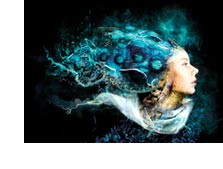Epsonow Magazine
Page 26 - Digital fine arts

Michelangelo's David. Da Vinci's Mona Lisa. Only two examples of art that are regarded around the world as true treasures of humankind.
While marble and canvas represent traditional art mediums, advances in software and hardware technology over the last two decades have made the personal computer a legitimate art medium. Now, even an entry level PC with relatively inexpensive software delivers all artists with phenomenally powerful tools for the creation of what is known as digital fine art.
Of course, while many traditional artists suffer the frustration of trying to have their artwork placed on display, digital artists have the advantage of being able to display and distribute their work over the Internet. This point not lost on Steve Danzig, a leading Australian digital artist and director of the International Digital Art Awards (IDAA).
In June 2000, Mr Danzig established IDAA and "put out a call" to digital artists around the world, encouraging them to use the Internet as a venue to display their digital art. The result was nothing short of amazing. By March 2001, more than 1,500 images had been submitted from around the world, all from artists vying for the honour of winning the inaugural International Digital Art Award.
"The enormous amount of interest that's been shown in IDAA is proof in itself that digital fine art is becoming ever more recognised as a serious art form," commented Mr Danzig. "At one point, we were receiving around 300 e-mails a day, which prompted us to establish our on-line newsletter and an IDAA preview page on our Web site." Mr Danzig attributes much of the initial interest in IDAA to the sponsorship provided by Epson Australia - Epsonow Magazine Volume 1, Digital Photography and Design magazine, Artistscope and Studio 211. "With companies like this - all of which are virtually synonymous with digital fine art - supporting the initiative, our database of subscribers has grown to over 30,000," he said.
From Screen To Paper
Following IDAA's online success, a three year international tour of the top 100 entries commenced on the 1st of June 2001. From the first showing at the Noosa Regional Gallery, the tour will progress across Australia then on to Russia and the United States in 2002.
Epson Australia's role in the IDAA? Quite literally, the foundation of the tour. All exhibited prints have been generated by an Epson Stylus Pro 9500, a large-format inkjet printer featuring Epson ColorFast pigment based ink.
"One of the main reasons I approached Epson to sponsor the IDAA was the company's proven understanding and delivery of technologies that are perfect tools for digital artists," explained Mr Danzig. "The prints we're taking on tour have a 200 year lightfast* rating - that's three times longer than traditional giclee prints using pigment inks on museum quality paper".
"It's important to bear in mind that the prints are going to be viewed by some of the world's foremost art experts. Anything less than a perfect print would only damage the reputation of IDAA and in all probability, have a detrimental effect on the broad acceptance of digital fine art as a serious art form."
Also lending support to IDAA's success has been the participation of leading international artists and art scholars. Heading the judging panel is US artist, Mr Gartel, who is considered a pioneer of the digital art movement. In the 80s, Laurence gained prominence with his ABSOLUT GARTEL art.
"Laurence has been committed to making the IDAA a huge success," said Mr Danzig. "We're incredibly fortunate to have someone of his standing prepared to co-brand his name with the IDAA. In recognition of his contribution to art history we felt it would be a great honour to have the major award, 'The IDAA Laurence Gartel Award For Excellence' in his name."
Other judges include Dr Sasha Grishin, a prominent art historian from the Australian National University; Dianne Mantzaris, who is considered to be one of the founders of digital art in Australia; US artist Jim Sellars who is also the Director of Studio 211; leading Russian artist Vladimir Zunuzin; and IDAA Director Steve Danzig.
The IDAA Winners
Within the IDAA winning entries, two Australian artists gained placings. Christos Magganas, who now lives in London, was awarded third place and Graham Levi, sixth.
It fell to Italian artist, Alessandro Bavari, to take out the 2001 International Digital Art Awards Laurence Gartel Award for Excellence. Bavari regards himself as a direct heir of the great European fine-art tradition. A spiritual descendent of such renowned fellow countrymen as Giotto, Michelangelo and Piero della Francesca - even though he has exchanged his paint brushes and canvases for a Macintosh computer.
Over 100 entries, including all those gaining award places, can be seen on the IDAA Web site at: http://www.worlddigitalart.com
If any reader would like more information on IDAA, Steve Danzig invites e-mails to: giznad@ozemail.com.au
